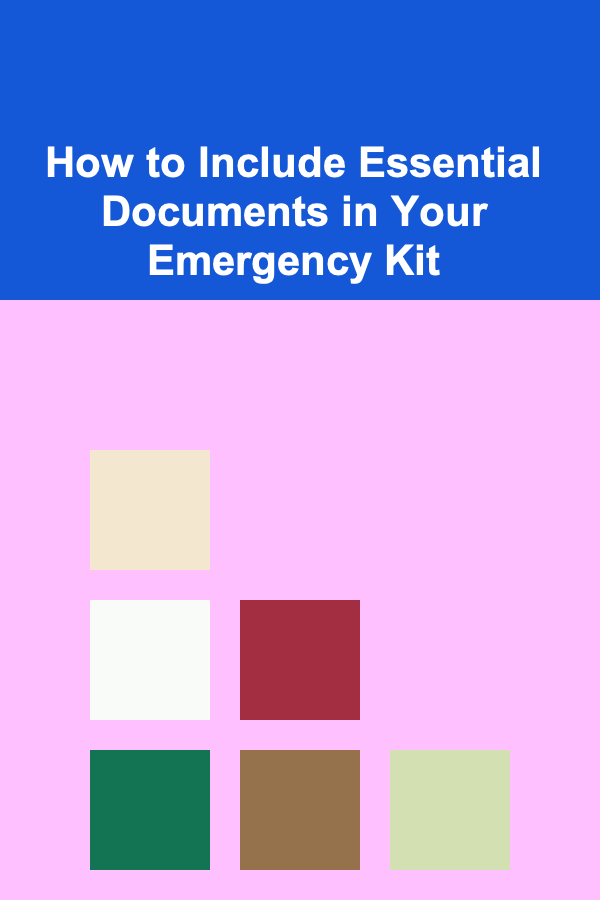How to Integrate Your Emergency Fund Tracker with Your Budget
ebook include PDF & Audio bundle (Micro Guide)
$12.99$7.99
Limited Time Offer! Order within the next:
An emergency fund is a critical financial tool, offering you peace of mind in times of unexpected financial hardships. Whether you're facing an unforeseen medical emergency, a sudden car repair, or a temporary job loss, having an emergency fund can significantly reduce stress and help you maintain financial stability. However, it's not enough to simply have an emergency fund; it's equally important to integrate it effectively into your overall financial strategy, especially your budget.
This article will delve into the concept of an emergency fund, explore the best practices for tracking it, and show you how to seamlessly incorporate your emergency fund tracker into your budgeting system. By the end, you'll understand how to keep your emergency fund working for you and how to make it an integral part of your financial planning.
Understanding the Role of an Emergency Fund
An emergency fund is designed to cover unexpected expenses that can disrupt your financial stability. Ideally, this fund should be easily accessible, liquid (meaning it can be quickly converted to cash), and used strictly for emergencies. According to financial experts, an emergency fund should be large enough to cover three to six months of living expenses. This amount varies depending on individual circumstances, but it provides a cushion for situations such as:
- Job loss
- Medical emergencies
- Unforeseen home repairs
- Car breakdowns
- Major life events like a wedding or divorce
An emergency fund allows you to avoid relying on credit cards or loans in these situations, thus protecting you from debt and high-interest payments. It's a fundamental component of a well-rounded financial strategy, providing you with financial security and flexibility when life throws a curveball.
Setting Up Your Emergency Fund
Before we discuss how to integrate your emergency fund with your budget, it's essential to understand how to set it up. The steps for establishing your emergency fund include:
-
Calculate Your Monthly Expenses
Begin by calculating your monthly living expenses, including rent/mortgage, utilities, groceries, insurance, transportation, and any other recurring costs. This gives you an idea of how much you need to save to cover three to six months of expenses.
-
Set a Goal
Based on your monthly expenses, determine your emergency fund goal. If your monthly expenses total $3,000, for instance, you should aim to build a fund of at least $9,000 to $18,000. This target will guide your savings efforts.
-
Start Small and Build Over Time
If the total amount seems daunting, don't worry. Start with smaller, more manageable goals. A good approach is to build your emergency fund in phases, first saving $1,000 for a starter fund and then gradually increasing it to cover three to six months of expenses.
-
Choose the Right Savings Account
Your emergency fund should be stored in a liquid account, such as a high-yield savings account or a money market account, to ensure it remains easily accessible when needed. It's important not to invest your emergency fund in stocks or long-term investments, as you may need quick access to the money in case of an emergency.
Why Integrating Your Emergency Fund with Your Budget is Crucial
Integrating your emergency fund into your budgeting system is essential for several reasons:
-
Helps You Stay On Track
If you're not actively tracking your emergency fund as part of your budget, you may lose sight of your progress or inadvertently dip into it for non-emergencies. By integrating it with your budget, you can stay committed to your financial goal and ensure that your emergency fund remains intact.
-
Prevents Over-Spending
Knowing exactly how much you have in your emergency fund and how much you need to add each month helps you make better spending decisions. It forces you to prioritize your financial goals, ensuring that you're not overspending in other areas while trying to save for emergencies.
-
Provides Financial Clarity
By including your emergency fund in your budget, you get a clear picture of your financial situation. You can assess how much you need to allocate toward savings versus spending each month. This can help you make adjustments to your overall financial strategy if needed.
-
Ensures Accessibility
The key to an emergency fund is that it's easily accessible. By integrating it with your budget, you're more likely to keep it liquid and avoid using it for non-emergencies.
How to Integrate Your Emergency Fund Tracker with Your Budget
The process of integrating your emergency fund tracker into your budget involves more than just tracking the fund's balance. It requires a systematic approach that makes it easy to assess how much you've saved and how much more you need to save, ensuring that you are steadily working toward your goal.
Step 1: Set Up a Separate Line Item for Your Emergency Fund
To start, add a separate line item for your emergency fund in your budget. This will allow you to track how much you're contributing each month and compare it against your savings goal. Whether you're using a spreadsheet, a budgeting app, or pen and paper, make sure to allocate a portion of your monthly budget toward your emergency fund.
Example :
If your emergency fund goal is $15,000 and you're aiming to build it over the course of a year, you would need to save approximately $1,250 per month. Your budget will reflect this expense as a fixed monthly allocation.
Step 2: Track Your Contributions
To stay on track, you must regularly update your emergency fund tracker with the amount you've saved each month. This can be done in various ways, such as:
- Spreadsheet: Use a simple Excel or Google Sheets document where you can log your deposits and track your balance.
- Budgeting Apps: Many budgeting apps, like Mint, YNAB (You Need a Budget), or EveryDollar, allow you to create categories and track savings goals.
- Manual Tracking: If you prefer a more analog approach, you can manually record your deposits and updates in a dedicated notebook or ledger.
Make sure to update your tracker immediately after each contribution to avoid forgetting or miscalculating the balance.
Step 3: Allocate Savings Before Spending
When planning your budget each month, make sure you prioritize your emergency fund. Ideally, savings should come before discretionary spending. This means that when you set your monthly budget, the first "expense" should be your emergency fund contribution.
To make this process more manageable, try automating your contributions. Set up an automatic transfer from your checking account to your emergency fund account to ensure consistent savings without having to think about it each month.
Step 4: Monitor Progress and Adjust When Necessary
Your emergency fund is a dynamic part of your financial life, and it's important to periodically review it and adjust as necessary. Life circumstances can change, and so can your financial goals. For example, if your income increases, you may be able to allocate a larger portion of your budget to your emergency fund. Similarly, if you experience unexpected expenses, you may need to slow down your contributions temporarily.
At least once every quarter, assess your progress. If you're ahead of schedule, consider increasing your contributions to reach your goal faster. If you're behind, you may need to adjust your spending or decrease discretionary expenses to get back on track.
Step 5: Use Your Emergency Fund Only for Emergencies
One of the most important aspects of keeping your emergency fund integrated into your budget is ensuring that it's only used for true emergencies. Avoid the temptation to dip into it for non-urgent expenses, such as vacations or impulse purchases.
To keep your emergency fund intact, be mindful of your budget and avoid unnecessary spending. If you do need to use your emergency fund for a legitimate expense, adjust your budget to replenish it as soon as possible.
Conclusion
Integrating your emergency fund into your budgeting system is crucial for maintaining financial stability. By carefully planning and tracking your emergency fund contributions, you can ensure that you're always prepared for life's unexpected events. Regular monitoring and adjusting your budget will help you stay on track, reach your savings goals, and prevent over-spending.
Remember, an emergency fund is not just a savings goal; it's a financial tool that provides peace of mind. By seamlessly incorporating it into your budget, you're taking a proactive step toward securing your financial future.
Reading More From Our Other Websites
- [Home Budget 101] How to Use Budgeting Apps and Tools to Manage Your Home Finances Effectively
- [Personal Investment 101] How to Set Financial Goals and Align Your Investments with Them
- [Personal Finance Management 101] How to Set Realistic Financial Goals Based on Your Income
- [Home Budget Decorating 101] How to Upgrade Your Home's Curb Appeal on a Budget
- [Personal Investment 101] Turn Deep Learning Knowledge into Profits with AI-Powered Products
- [Small Business 101] How to Build a Community‑Driven Loyalty Program for Independent Bookstores
- [Organization Tip 101] How to Teach Kids About Holiday Decoration Traditions
- [Home Party Planning 101] How to Create a Unique Guest List That Fits Your Party Style
- [Scrapbooking Tip 101] Time-Saving Scrapbooking Hacks Every DIY Enthusiast Needs
- [Toy Making Tip 101] From Concept to Creation: Essential Tools for Crafting Handmade Toys

How to Avoid Common Investment Mistakes for Beginners
Read More
How to Include Essential Documents in Your Emergency Kit
Read More
How to Train for a Mountain Trek
Read More
How To Incorporate Prebiotics for a Healthy Skin Microbiome
Read More
How to Build a Pre-Publishing Checklist for Bloggers
Read More
10 Tips for Mastering the Break Shot in Billiards
Read MoreOther Products

How to Avoid Common Investment Mistakes for Beginners
Read More
How to Include Essential Documents in Your Emergency Kit
Read More
How to Train for a Mountain Trek
Read More
How To Incorporate Prebiotics for a Healthy Skin Microbiome
Read More
How to Build a Pre-Publishing Checklist for Bloggers
Read More